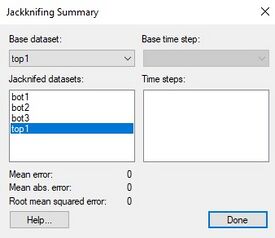GMS:Jackknifing: Difference between revisions
No edit summary |
|||
| Line 8: | Line 8: | ||
For transient datasets, the ''Base time step'' can be selected. For a transient jackknifed dataset, a list of available time steps will be display. Each available time step can be selected to view the summary data for that time step. | For transient datasets, the ''Base time step'' can be selected. For a transient jackknifed dataset, a list of available time steps will be display. Each available time step can be selected to view the summary data for that time step. | ||
[[File:JackknifingSummary.jpg|thumb|none|center|275 px|Example of the ''Jackknifing Summary'' dialog.'']] | :[[File:JackknifingSummary.jpg|thumb|none|center|275 px|Example of the ''Jackknifing Summary'' dialog.'']] | ||
==See also== | ==See also== | ||
Revision as of 14:49, 24 October 2017
Jackknifing is a special type of interpolation which can be useful in analyzing a scatter point set or an interpolation scheme. When the Jackknifing command is selected, the active scatter point set is interpolated to itself using the currently selected interpolation scheme. This process can take several minutes. Each point in the set is processed one at a time. The point is temporarily removed and the selected interpolation scheme is used to interpolate to the location of the missing point using the remaining points. Ideally, the interpolated value should correspond closely to the original measured value at the point. By interpolating to each point, a new dataset is generated for the scatter point set.
This new dataset can be compared with the original dataset using the Summary command in the Interpolation menu. The command brings up the Jackknifing Summary dialog.
Jackknifing Summary Dialog
Select an original dataset. under Base dataset, then select the dataset created from jackknifing, under Jackknifed datasets. The Mean error, Mean absolute error, and the Root mean squared error are automatically calculated.
For transient datasets, the Base time step can be selected. For a transient jackknifed dataset, a list of available time steps will be display. Each available time step can be selected to view the summary data for that time step.
See also
GMS – Groundwater Modeling System | ||
|---|---|---|
| Modules: | 2D Grid • 2D Mesh • 2D Scatter Point • 3D Grid • 3D Mesh • 3D Scatter Point • Boreholes • GIS • Map • Solid • TINs • UGrids | |
| Models: | FEFLOW • FEMWATER • HydroGeoSphere • MODAEM • MODFLOW • MODPATH • mod-PATH3DU • MT3DMS • MT3D-USGS • PEST • PHT3D • RT3D • SEAM3D • SEAWAT • SEEP2D • T-PROGS • ZONEBUDGET | |
| Aquaveo | ||
